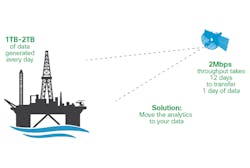Downtime is expensive for any manufacturer, but downtime in the oil and gas industry—needless to say—is extremely expensive. According to an MIT Sloan study, a single day of downtime for a liquefied natural gas (LNG) facility can cost $25 million. And a typical midsize LNG facility goes down about five times a year.
With the new reality of oil prices hovering around $50 a barrel, the oil and gas industry has moved well beyond its “drill, baby, drill” mentality and has begun embracing new technologies to improve efficiencies—and minimize unplanned downtime. That means, in particular, oil producers have become much more open to the ideas behind the Internet of Things (IoT).
“If you tried to talk about IoT last year or the year before, you were asked to leave,” commented Stephen Sponseller, director of market insights, oil and gas, for PTC. “It seems like all that has changed now.”
But the Industrial IoT (IIoT) brings with it challenges as well. Aside from security concerns, which could fill a page or two on their own, the oil and gas industry is particularly susceptible to network bandwidth limitations. As Sponseller related, what PTC hears from its customers are things like: “We have enough challenges with SCADA communications already.”
Which is a big reason why, at PTC’s LiveWorx conference earlier this year, Sponseller was focused on the importance of edge computing—performing analytics closer to where the data is being gathered—in the promise of IIoT in oil and gas.
There’s no question that, like many others, the oil and gas industry is becoming more and more connected all the time. The increase in industrial connected devices, Sponseller noted, is a combination of new smart connected products and legacy equipment retrofitted with sensors and gateways.
The oil and gas industry faces communication issues unlike many other industries, however. According to Cisco, a typical offshore oil platform generates 1-2 TB of data every day. The communication link to get that data to a central repository is typically a satellite connection—through which data travels at a rate of 64 Kbps to 2 Mbps. The end result, as Sponseller pointed out: “To get data off a rig would basically take 12 days,” he said. “For one day of data.”
The answer is not to collect less data. “Data scientists need high-frequency data in order to correctly model their system or machine,” Sponseller said. “If they’re taking samples that are not fast enough, it could affect the model.”
Latency is also an issue because the usefulness of data is often lost if not used immediately—particularly data related to platform efficiency and safety.
Sponseller showed a traditional SCADA/IoT architecture (shown above). It has challenges with data fidelity, latency and data loss. “Any time these wireless networks go down, real-time data is gone,” he said. The traditional architecture also uses insecure protocols such as Modbus, he added.
With edge data collection and analytics (also shown above), edge servers are embedded in IoT gateway devices so that data can be collected and analyzed locally—close to the sensors—instead of being sent to the remote SCADA system. “They can be sending data in parallel to the SCADA system and also to the IoT system for analytics,” Sponseller explained.
This setup also enables decisions to be made about the importance of data—not constantly pushing data every set time interval if nothing has changed, for example. “If you’re able to push data from the devices only on data changes, you could save the amount of raw data going across your network,” Sponseller said. “Collect data more often, but only give it to me when I ask for it.”
Other benefits include local buffering so that, if the network does go down, the data isn’t lost. Also, it could use more appropriate, secure protocols for transmission, such as MQTT, OPC UA, AMQP, CoAP, etc.
The move to the edge that Sponseller advocates for the oil and gas industry is part of an industry-wide trend to be able to use the data closer to where it’s collected. “By 2019, 45 percent of IoT-created data will be stored, processed, analyzed and acted upon close to or at the edge of the network,” said Robert Schmid, chief IoT technologist for Deloitte Digital, also speaking at LiveWorx. “That’s a shift that we’re going to have to deal with.”
About the Author
Aaron Hand
Editor-in-Chief, ProFood World

Leaders relevant to this article:
